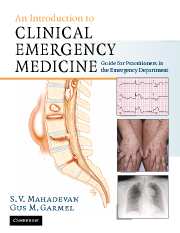Book contents
- Frontmatter
- Contents
- List of contributors
- Foreword
- Acknowledgments
- Dedication
- Section 1 Principles of Emergency Medicine
- Section 2 Primary Complaints
- 9 Abdominal pain
- 10 Abnormal behavior
- 11 Allergic reactions and anaphylactic syndromes
- 12 Altered mental status
- 13 Chest pain
- 14 Constipation
- 15 Crying and irritability
- 16 Diabetes-related emergencies
- 17 Diarrhea
- 18 Dizziness and vertigo
- 19 Ear pain, nosebleed and throat pain (ENT)
- 20 Extremity trauma
- 21 Eye pain, redness and visual loss
- 22 Fever in adults
- 23 Fever in children
- 24 Gastrointestinal bleeding
- 25 Headache
- 26 Hypertensive urgencies and emergencies
- 27 Joint pain
- 28 Low back pain
- 29 Pelvic pain
- 30 Rash
- 31 Scrotal pain
- 32 Seizures
- 33 Shortness of breath in adults
- 34 Shortness of breath in children
- 35 Syncope
- 36 Toxicologic emergencies
- 37 Urinary-related complaints
- 38 Vaginal bleeding
- 39 Vomiting
- 40 Weakness
- Section 3 Unique Issues in Emergency Medicine
- Section 4 Appendices
- Index
35 - Syncope
Published online by Cambridge University Press: 27 October 2009
- Frontmatter
- Contents
- List of contributors
- Foreword
- Acknowledgments
- Dedication
- Section 1 Principles of Emergency Medicine
- Section 2 Primary Complaints
- 9 Abdominal pain
- 10 Abnormal behavior
- 11 Allergic reactions and anaphylactic syndromes
- 12 Altered mental status
- 13 Chest pain
- 14 Constipation
- 15 Crying and irritability
- 16 Diabetes-related emergencies
- 17 Diarrhea
- 18 Dizziness and vertigo
- 19 Ear pain, nosebleed and throat pain (ENT)
- 20 Extremity trauma
- 21 Eye pain, redness and visual loss
- 22 Fever in adults
- 23 Fever in children
- 24 Gastrointestinal bleeding
- 25 Headache
- 26 Hypertensive urgencies and emergencies
- 27 Joint pain
- 28 Low back pain
- 29 Pelvic pain
- 30 Rash
- 31 Scrotal pain
- 32 Seizures
- 33 Shortness of breath in adults
- 34 Shortness of breath in children
- 35 Syncope
- 36 Toxicologic emergencies
- 37 Urinary-related complaints
- 38 Vaginal bleeding
- 39 Vomiting
- 40 Weakness
- Section 3 Unique Issues in Emergency Medicine
- Section 4 Appendices
- Index
Summary
Scope of the problem
Syncope is defined as a transient loss of consciousness and postural tone caused by an abrupt decrease in cerebral perfusion, with subsequent spontaneous recovery. When recovery occurs prior to complete loss of consciousness, the episode is referred to as pre- or near-syncope. Syncope and pre-syncope are generally considered the same condition at different points along a continuum. Therefore, the emergency department (ED) evaluation and work-up for both is similar.
Syncope is a common presenting complaint in the ED. It accounts for approximately 1–3% of ED visits and 1–6% of hospital admissions. As much as $750 million per year is spent in the US to diagnose and treat syncope. The differential diagnosis of syncope includes both benign and life-threatening etiologies. Emergency physicians must have a sound knowledge of diagnostic considerations in order to perform an adequate and cost-effective work-up and make appropriate disposition decisions.
Pathophysiology
Consciousness is maintained through the proper functioning of the cerebral hemispheres and the reticular activating system (RAS). Syncope occurs when there is dysfunction of either both cerebral hemispheres or the RAS. Proper function of these structures depends on cerebral metabolism and delivery of oxygen and glucose. Disruption of this metabolism can occur because of generalized systemic hypoperfusion (e.g., cardiac dysrhythmia, hypovolemia with orthostasis), localized cerebral hypoperfusion (e.g., transient ischemia attack, stroke), systemic hypoxia, or hypoglycemia.
History
Syncope has many causes, some benign and others life-threatening. As many as 45% of cases of syncope remain undiagnosed after a standard work-up.
- Type
- Chapter
- Information
- An Introduction to Clinical Emergency MedicineGuide for Practitioners in the Emergency Department, pp. 517 - 530Publisher: Cambridge University PressPrint publication year: 2005



